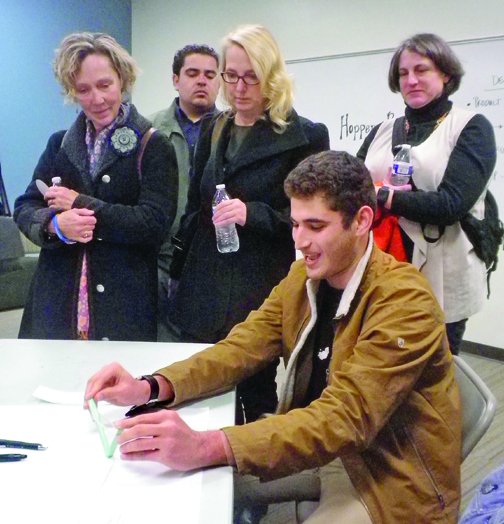
by Mark Smiley | Jan 29, 2018 | General Featured
The CUBE Focuses On Innovative Learning And Real-World Experiences
by Ruthy Wexler
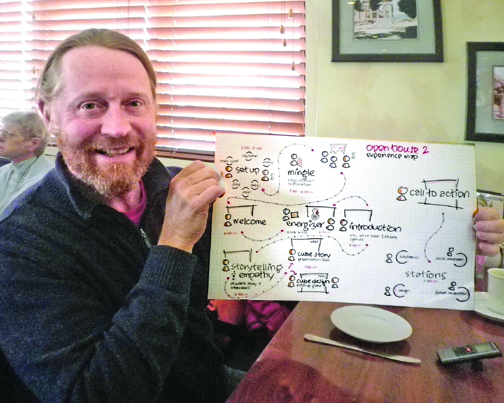
Co-Founder: Jim Stephens, co-founder of The CUBE, displays his plans for the Open House that was held on January 8, 2018. Stephens hopes to have enough students enrolled by the end of February 2018. The requirement is 93.
The CUBE, a new high school in Denver, is ready to enroll students and eager to explain how their innovative program not only boosts reading, writing, and math skills, but connects students to the real world — and their best selves.
Since Denver Public School’s school choice enrollment takes place February 1-22, The CUBE held a series of Open Houses in January, “so kids and parents could see who we are and what we do.” At the first one, held on January 8 in The CUBE’s temporary home, Vickers Boys and Girls Club, an attentive, curious group began to grasp how profoundly different this school would be.
“But don’t you have … classes?” one mother asked.
“Yes, we have classes,” smiled co-founder Bret Poppleton. “But they’re not what you’re used to. One course students can take first semester is ‘Flour, Water, Salt and Yeast.’”
“They bake bread?” said a puzzled adult.
“Yes. And that’s fun and engaging. But they also learn chemistry, math, research, writing … because all those things are involved.”
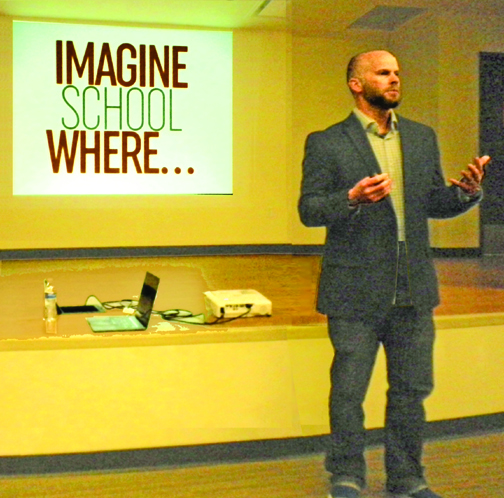
Presentation: Bret Poppleton, co-founder of The CUBE, explains CUBE concepts to parents at the Open House. School Choice for Denver Public Schools runs from February 1 to 28, 2018, and CUBE supporters hope to enroll 135 students.
Because It Was Real
“We call our courses ‘mash-ups,’” Poppleton explained. “An interdisciplinary smashing together of ideas that teaches students to think more deeply about the world. It’s actually how real learning happens. Not linear but from all directions. Starts with being engaged.”
He shared an epiphany. “In middle school, I was always complaining, ‘Why do I have to learn this?’ Then, between 10th and 11th grade, I spent a week in construction, building homes. I learned more that week, it seemed, than in a whole year of school. Because it was real.”
The CUBE’s other founder, Jim Stephens, told much the same story. “Between my sophomore and junior years of college, I went to Jamaica, a summer field school for anthropology. At first, I thought, great, a vacation. But doing excavations right there on sugar plantations with descendants of enslaved people, I understood history so deeply. I drew the artifacts, made maps. It all connected. For the first time in my life, learning came alive.”
Based On Research
What happened in Jamaica — what will occur at The CUBE — is “integrated learning,” said Stephens, who honed his educational skills for years before embarking on a “national search for the kind of place I wanted to teach” — and landed at the Denver School of Science and Technology (DSST).
“I learned so much there,” recalled Stephens, whose passionate interest in the swiftly-shifting future was shared by DSST colleague Bret Poppleton.
The more the two learned how the world was changing — how radically different the work force will soon appear — the more they wanted to equip students with the skills to “pivot”; i.e., change direction with confidence.
Soon they agreed: “Let’s open up our own school.”
“First, we needed to understand the teenage brain the same way that Montessori understands the early years,” Stephens recalled. “Studies show, for example, that the brain’s sleep pattern changes markedly during adolescence. That’s why teens fall asleep in early classes. Our classes won’t start until 9 a.m.” [Although The CUBE will stay open from 7 a.m. to 7 p.m.]
Questions
On January 8, impressed parents nonetheless had worries.
“What about standardized testing?”
“Yes, we take them. All our kids will learn to read, write, compute and think, skills absorbed so much more easily when engaged,” said Poppleton.
“Is there homework?”

Demonstration: Abcim Molavi, former student of The CUBE’s co-founders, demonstrated his solution to the Hopper Project as parents look on at the Open House held in January. The Hopper Project is statistical machine learning for advanced search of mathematical and scientific literature.
“Working on a project, doing research, that’s homework,” Poppleton said. “But they’ll love what they’re doing and learn more.”
“What about transcripts?”
“We have a transcript format that includes the traditional information, as well as social-emotional and 21st century skills data.”
“Accountability?”
“We offer fun and engagement, so we expect more participation. But we have expectations too. When students finish one of the mash-up classes, they must do three things: write a paper, create a product, do a presentation.”
Future
Earlier, Jonathan Best, The CUBE’s “Computation Jedi,” had led students to an adjoining room. After an hour, parents joined the kids, who’d been divided into groups and instructed to build “something that moved” from a box of ordinary objects.
“We’re telling them, ‘You’re smart, you can figure out how to build something that moves from these few materials,’” explained Best. “It’s not about competing. It’s building confidence to think outside the box.”
The CUBE’s founders excitedly envision a student body “where every kid knows how to code,” week-long courses “that take place in the real world, like an ice-climb in Ouray,” unlocking “the huge potential inside each child.”
Currently, they’re addressing the challenges of any new school.
“Fundraising. Finding the facility. Getting kids,” listed Poppleton. “We’ve already raised $2.5 million.”
“We’re going to take 135 students,” said Stephens. “Or more. But by the end of February, we have to have 93.”
What if too few sign up?
He smiled gently. “Well… then people aren’t ready for our school.
“But I hope they are. We’re ready for them! We can’t wait to show how powerful storytelling and empathy and mash-up classes are.
“We don’t use the term ‘alternative’ — because we believe all schools should look like this. And will, in the future.
“It’s just that The CUBE is doing it now.”
For more information, go to www.thecubeschool.org.

by Mark Smiley | Dec 17, 2017 | General Featured
Piano Playtime For Preschool Children Hits All The Right Notes With Valley Parents
by Glen Richardson

Child’s Play: Students at newly launched Gymboree Play & Music get the best possible start in overall brain development, confidence, and just plain old fun.
All right everybody gather around because the Piano Playtime kids are here. What kind of tune do you want to hear? They can play anything you want because they’re smart.
What is Piano Playtime you ask? It’s a carefully designed program for two-and-a-half to five-year-olds. Around for more than 30 years, it currently serves many private preschools in Denver’s north and west suburbs. This fall the program was formally launched at Gymboree Play & Music at I-25 and Hampden. In-home classes for groups of four or more are also offered.
Why? It gives your young one the best possible start in overall brain development, confidence, and just plain old fun! Many Piano Playtime veteran families have watched their young ones grow into amazing young musicians. They have balanced interests and varied strengths and continuous joy in learning. The program uses a rich, play-based curriculum for preschoolers. It is based on recent research in early piano learning to promote child brain development. Instruction is rooted in Gordon Research, Kodaly, Montessori, and Suzuki principles. It uses “ear before eye” for concentrated neuro-network activity. It builds higher intelligence, encourages full brain integration and full use of all sensory inputs.
Studies Support
Many recent studies in Neuroscience conclude that learning to play the piano during the preschool years is the most beneficial of any activity for building intelligence and brain function, increasing neuro-networking, concentration, coordination, confidence and brain integration. Learning piano before the age of seven grows physically larger brains. Moreover, preschool classes in violin, computers and foreign languages pale in comparison.
Piano Playtime has been carefully designed in program and curriculum to emulate language learning and literacy because music is a language, the universal language. We all learn to fluently speak our mother tongue by age six, quite miraculously without any formal study. Just being in a community with loving family, friends and loved ones gives the impetus to learn our language in a very natural and amazing way, auditory. Thus, music, specifically piano, is learned in the same way, beginning at age three when the auditory inputs are at their maximum and finger isolation begins to develop.
This is especially important for little boys. They are typically born without the ability to integrate L/R brain and are often 12-18 months behind in brain development throughout the preschool-early elementary years.

Preschool Brilliance: The piano tops computer, foreign language and violin classes in helping preschoolers function at higher levels.
Keyboard Playing Field
Many parents spend $50 or more per month for their preschoolers to play sports or other activities that have little effect on brain development or basic intellectual growth through increased brain size. Piano is the only activity that has been proven to do this. The studies are numerous and staggering in their conclusions: such as the piano tops computer, foreign language and violin classes in helping preschoolers function at higher levels and use more of their brain not only during class times but transferring to all other areas of neural function. The benefits last for a lifetime. Seems like a small price to pay for such enormous benefits.
Considering how critical the preschool years are for developing neural networks that last a lifetime, it seems shortsighted in point of view to keep preschool piano as a “luxury” rather than a staple for preschoolers.
Pre-K Standards
Piano activates, accelerates and permanently expands many neuron centers of learning. This includes speech-language, fine motor, auditory processing, visual-spatial reasoning, social-interactive, cognition, confidence and more. Playing by ear, learning beginning pre-reading skills, improvising, and creating music are all basics of the Whole Music Approach (WMA).
The program offers a well-designed curriculum based on research, natural developmental stages of children. Furthermore the curriculum is in alignment with the MENC National Standards for Pre-K. Providing fun and motivational support are key principles of the approach. WMA facilitates interactive learning and positive life skills. Parent education is a vital part of the curriculum.
The staff works with parents and caregivers to understand the vital happenings within the children’s environment that stimulate accelerated brain development, intelligence and activate nourishing relationships within the family through the children’s day to day musical learning. They make sure that parents know what is happening in the classes, encourage parent attendance and provide in-home music activities. A small class size of four to six children makes it piano intensive. Along with deeply caring parents, family, teachers and community, these benefits can only help expand the forward movement of human evolution.
Playful Package
“Play” is learning for the young child and the program takes your child’s play seriously. There is no other time in a child’s life when piano is so critical for accelerated brain growth. At Playtime classes in Denver and the Cherry Creek Valley, the Whole Music Approach (WMA) is used to develop young musicians who can play by ear, improvise freely and later compose and read music.
Youngsters are encouraged to create their own pieces, based on what they have mastered through reading music. Whatever style of piano kids and their parents would like to learn, instructors can customize lesson plans. The Whole Music Method paired with a piano is also perfect for students to create a life-long love of music. Kids are encouraged to participate in regular recitals and on-going performances and concerts.

by Mark Smiley | Nov 20, 2017 | General Featured
by Glen Richardson
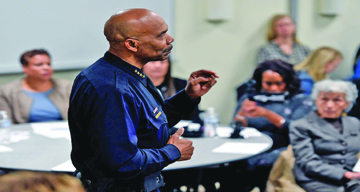 Denver Police have not implemented any recommendations from a 2016 audit meant to help officers avoid racial bias in patrol duties, a follow-up report in September 2017 finds. Denver Auditor Timothy M. O’Brien, CPA, made his original recommendations in a January 2016 audit of police operations, including updates to biased policing policies and demographic data collection.
Denver Police have not implemented any recommendations from a 2016 audit meant to help officers avoid racial bias in patrol duties, a follow-up report in September 2017 finds. Denver Auditor Timothy M. O’Brien, CPA, made his original recommendations in a January 2016 audit of police operations, including updates to biased policing policies and demographic data collection.
“It’s important for Denver Police policies to protect and serve all people equally,” explains Auditor O’Brien. “There is no way to tell if officers are stopping people without bias regarding race, gender or age if officers choose not to document demographic data.”
According to the American Civil Liberties Union (ACLU): Racial profiling refers to the practice by law enforcement officials of targeting individuals for suspicion of crime based on the individual’s race, ethnicity, religion or national origin. Criminal profiling, generally, as practiced by police, is the reliance on a group of characteristics they believe to be associated with crime. Examples of racial profiling are the use of race to determine which drivers to stop for minor traffic violations or the use of race to determine which pedestrians to search for illegal contraband.
the use of race to determine which pedestrians to search for illegal contraband.
Secret House Surveys
The previously agreed-upon recommendation involved communicating with the U.S. Department of Justice’s Office of Community Oriented Policing Services for options on how to utilize the Community Policing Self-Assessment Tool (CP-SAT). This tool could help officers evaluate the effectiveness of community policing efforts over time. Instead, Denver Police said it conducted other surveys to get input from staff. The Denver Police Foundation also conducted an independent community survey. Auditors were unable to see these survey results or the contents of the survey. Denver Police shared no information regarding the independent survey, which the Denver Police Protective Association (PPA) keeps for internal purposes.
“We cannot assess whether either survey met the spirit of or captured content similar to the CP-SAT survey,” the follow-up report says. “As a result, we consider this recommendation as having not been implemented,” the report concludes.
Other recommendations the department previously disagreed with included updating its Biased-Policing Policy to include an annual assessment of collected demographic data, and requiring officers to collect data for all pedestrian and traffic self-initiated contact. Currently, officers only collect this data for encounters that lead to a citation, arrest or street check.
Double Standard?
Within weeks following the auditor’s report, an overwhelming majority of Denver police officers say they have no confidence in the ability of Chief Robert White to lead the department. In a news conference on Oct. 24 Denver Police Protective As sn. President Nick Rogers announced than a survey of 582 union members yielded a 94 percent “no confidence” vote.
sn. President Nick Rogers announced than a survey of 582 union members yielded a 94 percent “no confidence” vote.
The vote, according to PPA, reflects a perception by the rank and file officers that there exists a lack of transparency within the police administration and a double standard applies to conduct of high-ranking members of the police administration,” Rogers told the conference.
When asked if the union had ever issued a “no confidence” vote before. Rogers replied, “Never.”
PR Policing Policy
The police department has long touted its community-oriented policing philosophy. Denver Police first incorporated community policing into its operations in the 1980s. However, without demographic data from police encounters there is no way to ensure community-policing efforts are effective or equitable. The department says it has communicated with stakeholders, including community leaders, about ways to collect more information. However, there is no plan in place at this time for collecting personal data from individuals about interactions with police.
The Department of Public Safety has not implemented any of the recommendations made in the Police Operations — District Patrol audit report. Accordingly, Auditor O’Brien has determined that the risk associated with the audit team’s initial findings has not been mitigated.
Auditor Timothy M. O’Brien, CPA, has more than 40 years of auditing and accounting experience and strives to bring greater clarity, transparency and accountability to Denver’s city government for its residents. Elected in 2015, he is distinguished from his predecessors by being an actual professional auditor. He is a licensed Certified Professional Accountant and holds the designations of Chartered Financial Analyst and Chartered Global Management Accountant.

by Mark Smiley | Oct 23, 2017 | General Featured
Celebrating Its 10th Anniversary, Attendees Can Choose From Music, Dance, Film Author Lectures
 The Valley isn’t lacking for festivals, but a select few consistently find a way to differentiate themselves in a crowded field. The 10th annual celebration of Jewish Arts, Authors, Movies & Music Festival (JAAMM) has distinguished itself from the crowd. The 18-day one-of-a-kind culture extravaganza opened Oct. 26 and Valley residents have an array of awesome choices as events continue through Nov. 12 at the Mizel Arts & Culture Center (Jewish Community Center).
The Valley isn’t lacking for festivals, but a select few consistently find a way to differentiate themselves in a crowded field. The 10th annual celebration of Jewish Arts, Authors, Movies & Music Festival (JAAMM) has distinguished itself from the crowd. The 18-day one-of-a-kind culture extravaganza opened Oct. 26 and Valley residents have an array of awesome choices as events continue through Nov. 12 at the Mizel Arts & Culture Center (Jewish Community Center).
The wide variety of November choices contrast from a showing of Ron Suskind’s award-winning film, Life, Animated, to the keynote speech by renowned film critic and historian Leonard Maltin. Also this month audiences can enjoy the Stomp-style Israeli percussion, dance troupe Tararam and acclaimed Israeli-American jazz pianist Tamir Hendelman plus operatic bass Anthony Mordechai Tzvi Russell, performing traditional Ashkenazi Jewish and African American music.
Celebrating the festival’s 10th anniversary there is a wide array of programming choices. Among the lineup of events remaining, several top selections stand out and are not to be missed:
Author Lectures
Author and Rabbi Naomi Levy has penned a book based on a poignant letter written by the 20th century’s most influential physicist Albert Einstein. She talks about the book titled Einstein and the Rabbi: Searching for the Soul in the Phillips Social Hall Nov. 2, 2 p.m. His words captured what she believes to be true about the human condition and how we are all intimately connected.
That evening in the Wolf Theatre renowned civil rights activist and speaker Morris Dees speaks at 7 p.m. He discusses how our commitment to justice for all will chart our nation’s future as America becomes more diverse and as economic disparity widens. Dees will share his experiences and insights, explaining why he became an attorney and founded the Southern Poverty Law Center. Prior to his talk there is a private reception from 5:30-6:30 p.m.
The author of Sons and Soldiers written by Bruce Henderson is another lecture you won’t want to miss. He tells the little-known stor y of nearly 2,000 German-born American Jews who enlisted in the U.S. Army and were sent overseas as a special unit interrogating German POWs. Known as the “Ritchie Boys,” their contributions in fighting Hitler were invaluable. He speaks in Phillips Social Hall Nov. 7 at 11 a.m. and the lecture is free for veterans.
y of nearly 2,000 German-born American Jews who enlisted in the U.S. Army and were sent overseas as a special unit interrogating German POWs. Known as the “Ritchie Boys,” their contributions in fighting Hitler were invaluable. He speaks in Phillips Social Hall Nov. 7 at 11 a.m. and the lecture is free for veterans.
Dance & Film
You’ll enjoy the excitement, beauty, timing and precision of dance when the Wonderbound Dance Company performs in the Wolf Theatre Nov. 9, 7:30 p.m. With live music accompaniment by Hal Aqua & The Lost Tribe, this is a high octane, humorous and poetically athletic extravaganza.
Described as one of the most truthful films about show business, see the documentary film Joan Rivers: A Piece of Work, showing in the Wolf Theatre Nov. 5, 7 p.m. It exposes the private dramas of the irreverent, legendary comedian and pop icon Rivers. Moreover, it is very funny.
Documentary film Mr. Gaga shows in the Wolf Theatre Nov. 12, 11 a.m. It tells the story of Ohad Naharin, the renowned choreographer-artistic director of Israel’s Batsheva Dance Company. Footage of intimate rehearsals and breathtaking dance sequences make this a breathtaking film.
Music & Singing
Drum-up friends and family to enjoy the Israeli Stomp-style drum and dance sensation Tararam at the Wolf Theatre on Nov. 4, 7:30 p.m. These performing artists produce a blend of rhythm, music, movement and wit, interwoven with choreographed body drumming, amusing sounds and theatrical antics.
Then on Sunday, Nov. 5 at 1:30 p.m. catch the Anthony Mordechai Tzvi Russell concert also in the Wolf Theatre. His singing combines 100 years of traditional Ashkenazi Jewish and African American music. Accompanied by Dr. Alan Mason his concert recently sold-out at the Berkeley Jewish Music Festival.
For many people there’s no better music than jaz z and if you’re one of them don’t miss award-winning jazz pianist Tamir Hendelman and his trio playing in the Wolf Theatre Nov. 11, 7:30 p.m. Playing alongside upright bassist Alex Frank and jazz drummer Dean Koba they are a phenomenon. Together the trio explores jazz standards, Brazilian music, blues and Tamir’s Israeli roots.
z and if you’re one of them don’t miss award-winning jazz pianist Tamir Hendelman and his trio playing in the Wolf Theatre Nov. 11, 7:30 p.m. Playing alongside upright bassist Alex Frank and jazz drummer Dean Koba they are a phenomenon. Together the trio explores jazz standards, Brazilian music, blues and Tamir’s Israeli roots.
The festival is open to the entire Cherry Creek Valley and features a wide array of multidisciplinary programs in addition to those listed. There’s plenty more to see and experience. Information: 303-316-6360 or maccjcc.org/jaamm.

by Mark Smiley | Sep 25, 2017 | General Featured
by Julie Hayden
 The little boy was just seven years old when he was brought to the Tennyson Center in Denver. It’s a refuge of last resort for children who have been abused, neglected or traumatized. Tennyson Center CEO Ned Breslin says this boy had been removed from the place he and his heroin-addicted mother had been staying. “His mother was bringing men to the apartment who paid her for sex and she then spent the money on heroin, not her son,” Breslin says. The boy was scared, significantly underweight and malnourished. Fortunately, teachers noticed he had “disappeared” from school and contacted authorities that stepped in. Breslin says the tragedy is, this boy’s story is becoming far too common in Colorado.
The little boy was just seven years old when he was brought to the Tennyson Center in Denver. It’s a refuge of last resort for children who have been abused, neglected or traumatized. Tennyson Center CEO Ned Breslin says this boy had been removed from the place he and his heroin-addicted mother had been staying. “His mother was bringing men to the apartment who paid her for sex and she then spent the money on heroin, not her son,” Breslin says. The boy was scared, significantly underweight and malnourished. Fortunately, teachers noticed he had “disappeared” from school and contacted authorities that stepped in. Breslin says the tragedy is, this boy’s story is becoming far too common in Colorado.
Like the rest of the nation, heroin and opioid abuse is skyrocketing in Colorado. Colorado Health Department statistics show 2016 saw a record number of opioid overdose deaths in Colorado — 912 people. That far surpasses the 600 people who died in traffic accidents.
There’s been a lot of talk and task forces focused on adults and the opioid crisis. But Breslin says children are the unseen and forgotten casualties of the opioid crisis. “The kids fall through the cracks.”
The Tennyson Center, founded in 1904, has a mission of empowering children who have experienced abuse, neglect and trauma to bravely and safely change their life’s story. It helps 200-300 local children and families each month. Breslin says, “We’re seeing a real disintegration of families. We’re seeing a real pressure from the opioid and drug epidemic that is ravishing our country and our state.”
The statistics are both staggering and heartbreaking. Breslin notes, “There’s been an 81% increase in the number of kids taken out of their homes over the last two years in Denver alone. And there’s been a 70% increase in abuse and neglect investigations in Denver.” Much of that is fueled by the opioid crisis. Breslin says, “The whole child welfare system is buckling under the pressure.”
Programs like the Tennyson Center are struggling to handle what he calls “the flood” of kids coming into the system. “We are seeing at Tennyson kids being taken from their homes who have been pimped out to pay for their parents’ drug habits. We are seeing kids who are 20-30 pounds underweight because their parents choose drugs over feeding their children. It’s a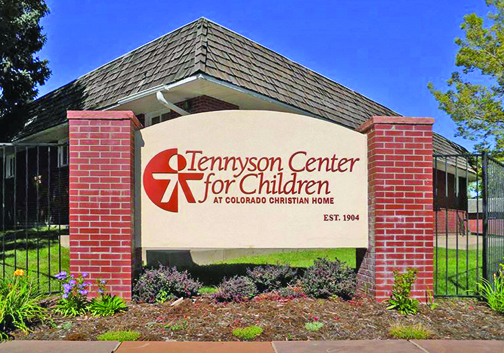 real problem.”
real problem.”
Tennyson Center, like other similar organizations, is at capacity and searching for ways to fill the growing need. Breslin describes their developing “No Kid Waits” program. “When you have a family and children in crisis it just doesn’t work when you have to tell them you’ll put them on a week-long waiting list. The crisis just gets worse. We have to find ways to get immediate help to these kids.”
The need for help is obvious but how to help is not so clear. Breslin explains it’s difficult enough to work with the kids who have been abused and/or neglected by an opioid addicted parent. But he says you also have to deal with the separation issue. “Mom is going through detox, the legal situation, but at the same time the kids miss her and want to reunite. The path to get kids stabilized and then back with their families is not very clear or easy to navigate.”
“If we can sit back as a society and say what should we really invest in — kids who are in this situation, how can we invest so there are better outcomes. We don’t need more money, we need to move in different ways,” Breslin asserts.
“We just have to realize all the stuff you’re seeing on the surface of the drug abuse and parents in crisis is true and we have to do something about it because we can’t forget the kids.”

by Mark Smiley | Aug 30, 2017 | General Featured
by Julie Hayden
It’s a peaceful neighborhood tucked just around the corner from Exposition and Quebec. The yards are carefully tended; flowers bloom and shady trees line the street in front of beautifully maintained homes.
But one house in this quiet neighborhood stands out like a sore thumb. “It’s an eyesore,” complains neighbor Deborah Costin. “The place is a mess. The grass is dead and full of weeds. A tree in the front yard is dead. The exterior paint is peeling and there is trash.”
Normally neighbors would take their complaints to Denver  City inspectors. But that doesn’t do any good in this case because the rundown property at 716 South Poplar in Denver, is owned by the City and County of Denver.
City inspectors. But that doesn’t do any good in this case because the rundown property at 716 South Poplar in Denver, is owned by the City and County of Denver.
Public property records show the three bedroom, two and half bath home with 2,268 square feet was built in 1964. In August 1998, the owners sold it to the City and County of Denver for $209,900. According to public records, a few months later, in October 1998 the City gave it to the Denver Urban Renewal A uthority, the property was rezoned and a year later DURA turned it over to Redi Corporation, which contracted with Mental Health Center of Denver (MHCD) to operate it as a group home for mentally ill residents.
uthority, the property was rezoned and a year later DURA turned it over to Redi Corporation, which contracted with Mental Health Center of Denver (MHCD) to operate it as a group home for mentally ill residents.
According to news reports and official City documents, the home was one of several Denver “scurried” to purchase to comply with a court order following a settlement in a lawsuit filed regarding mental health housing.
The City of Denver hurriedly rezoned the residential property to allow a group home, over the strenuous objections from the neighborhood association and individual neighbors.
But in spite of the frequent paramedic, fire and police sirens responding to 9-1-1 calls from the address the neighbors say they came to accept the group home in their midst and the property was kept in good condit ion.
ion.
That all changed when MHCD closed the group home and on March 25, 2016, the property was turned back over to the care and ownership of the City and County of Denver.
Costin says, “It’s been a year and a half of the house sitting there empty and steadily deteriorating. “She has pictures showing the yard sprouting only weeds with the grass long since dead. Other pictures show aging paperwork stuck in the door from the State of Colorado demanding information about a required inspection. There appears to be a hole in the eaves under the roof, the paint is peeling, roofing materials left as trash sit alongside the house.
“Who knows what is going on in the back as part of the fence fell down,” Costin adds.
The neighbors also have concerns about the inside of the house. They say last winter two neighbors walking their dogs noticed water pouring out the front door, down the sidewalk and into the street. They called 9-1-1 and the fire department responded and shut off the water. But nothing else was done for weeks and neighbors speculate there could be a serious mold problem.
Costin also questions whether the City of Denver is being a good steward of taxpayers’ dollars when it comes to this property. Sold in 1998 for the $209,900, Zillow and other real estate sites estimate the home is worth more than double that today, putting it around $560,000. And while public t ax assessment records show neighboring families are paying thousands of dollars in property taxes the City and County of Denver pays absolutely no taxes on 716 S. Poplar.
ax assessment records show neighboring families are paying thousands of dollars in property taxes the City and County of Denver pays absolutely no taxes on 716 S. Poplar.
Costin says, “Whatever upkeep is being done, utilities or insurance that are being paid is at taxpayer expense and the property value is rapidly plummeting given the deterioration of the house and yard.”
Costin and other neighbors ask, why doesn’t the City of Denver simply sell the property and let a new homeowner who will actually take care of the home enjoy it. “Why not put the property on the market so it could return to being a single-family residence in keeping with the neighborhood?”

Denver City Councilmember, Paul Kashmann
Denver City Councilman Paul Kashmann, whose District Six includes the South Poplar street neighborhood, says the City of Denver has no plans to sell the property. He explains Denver is in negotiations with a non-profit service provider to turn the house into a group home for homeless women to help them get back on their feet. He says the organization is in the process of applying for grants to fund the program and take over the property.
Kashmann says he understands the neighbors’ frustration with the deteriorating condition of the property, “Without question if I were a neighbor I would not be pleased,” Kashmann says. He adds he will see what he can do to push the City to take better care of the property in the meantime.
Denver City spokeswoman Courtney Law says the City has programs to provide regular maintenance of properties it owns and after being contacted by the Chronicle she passed neighborhood concerns to the maintenance people and says they will respond.
Neighbors remain skeptical and are not happy about the prospect of another group home at the property. Costin says, “Is that the best use for that house? No. It was a bad idea in 1998 and it’s a bad idea now.”




















